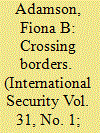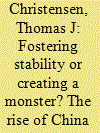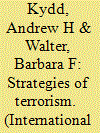|
|
|
Sort Order |
|
|
|
Items / Page
|
|
|
|
|
|
|
| Srl | Item |
| 1 |
ID:
073828


|
|
|
|
|
| Publication |
2006.
|
| Summary/Abstract |
International migration has moved to the top of the international security agenda, due in part to concerns that migration flows provide conduits for the spread of international terrorism. Although such concerns are not entirely unfounded, they must be placed within the broader context of the range of impacts-both positive and negative-that international migration flows have on states' core national security interests. Migration flows affect at least three dimensions of national security: state capacity and autonomy, the balance of power, and the nature of violent conflict. Overall, migration management presents a far greater security challenge to weak and failing states than to advanced postindustrial states. States that are able to formulate and implement migration policies that harness the power of international migration will be more secure, rather than less secure, in the new globalized security environment.
|
|
|
|
|
|
|
|
|
|
|
|
|
|
|
|
| 2 |
ID:
073826


|
|
|
|
|
| Publication |
2006.
|
| Summary/Abstract |
This article explores two starkly contrasting analytic approaches to assessing the performance of U.S. security strategy in East Asia since 1991: a positive-sum approach, emphasizing the danger of security dilemmas and spirals of tension, and a zero-sum approach, emphasizing power competition and the long-term dangers posed by China's rise. In the policy world, the differences between these apparently irreconcilable perspectives are not so clear. Certain policies-for example, maintaining a strong U.S.-Japan alliance-flow from either logic. Moreover, each approach sometimes counsels counterintuitive policy prescriptions that are generally associated with the other. Relatively assertive U.S. security postures apparently have furthered positive-sum regional goals by catalyzing China to adopt reassuring policies toward its neighbors as a hedge against potential U.S. encirclement. From a zero-sum perspective, the United States often competes more effectively for regional influence by cooperating with China than it would by seeking to contain China's economic growth and diplomatic influence.
|
|
|
|
|
|
|
|
|
|
|
|
|
|
|
|
| 3 |
ID:
073824


|
|
|
|
|
| Publication |
2006.
|
| Summary/Abstract |
Al-Qaida will end. The fear that a small terrorist organization with a loose network has transformed itself into a protracted global ideological struggle without an end in sight is misguided. There are centuries of experience with modern terrorist movements, many bearing important parallels with al-Qaida; yet the lessons arising from the demise of these groups are little studied. Unfortunately, terrorist organizations in their final stages are often at their most dangerous. The outcomes can range from implosion of a group and its cause to transition to astonishing acts of violence and interstate war. Comparing al-Qaida's differences and similarities with those of earlier terrorist organizations, and applying relevant lessons to this case, can provide insights into al-Qaida's likely demise. It can also inform thinking about how to manage and hasten al-Qaida's end.
|
|
|
|
|
|
|
|
|
|
|
|
|
|
|
|
| 4 |
ID:
073827


|
|
|
|
|
| Publication |
2006.
|
| Summary/Abstract |
The global number of child soldiers has grown significantly in the last two decades despite a series of protocols designed to curb this trend. They are generally employed in wars where belligerents spend more time attacking civilian populations than fighting professional armies. Used by both governments and rebel groups, child soldiers epitomize many of the problems associated with states at risk: intergenerational violence, poverty, and the failure of efforts to instill the rule of war. Both scholars in security studies and policymakers have largely regarded child soldier recruitment as a humanitarian issue. But recent events have linked child soldiering to insurgency and terrorism, suggesting that this issue is also developing a security dimension. This article examines contrasting arguments about the causes of child soldiering. Using data drawn from nineteen African conflicts, the authors argue that the major explanation for the significant variation in the percentage of child soldiers recruited is the degree of protection against abduction provided by governments and external actors to camps housing internally displaced persons and refugees.
|
|
|
|
|
|
|
|
|
|
|
|
|
|
|
|
| 5 |
ID:
073825


|
|
|
|
|
| Publication |
2006.
|
| Summary/Abstract |
Terrorism is designed to change minds by destroying bodies; it is a form of costly signaling. Terrorists employ five primary strategies of costly signaling: attrition, intimidation, provocation, spoiling, and outbidding. The main targets of persuasion are the enemy and the population that the terrorists hope to represent or control. Terrorists wish to signal that they have the strength and will to impose costs on those who oppose them, and that the enemy and moderate groups on the terrorists' side cannot be trusted and should not be supported. Each strategy works well under certain conditions and poorly under others. State responses to one strategy may be inappropriate for other strategies. In some cases, however, terrorists are pursuing a combination of strategies, and the response must also work well against this combination.
|
|
|
|
|
|
|
|
|
|
|
|
|
|
|
|
|
|
|
|
|